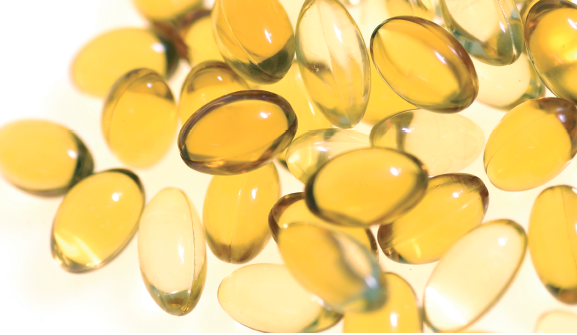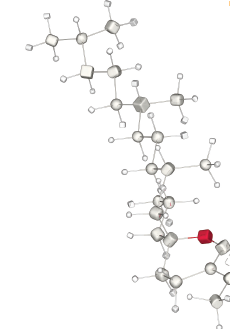Vitamin E
Obstacles and opportunities in cancer prevention and treatment
Abstract
Vitamin E is one of the most researched compounds in the medical community because of what is believed to be its reduced risk association with a multitude of diseases, including cancer. There are eight forms of vitamin E, four tocopherols and four tocotrienols. Alpha tocopherol is by far the most studied form because it is the most biologically active (Aggarwal 2010). Gamma tocopherol and tocotrienols have shown the greatest promise with respect to recent cancer research. Gamma tocopherol has been found to prevent cancer cell growth both in vitro and in animal models by decreasing the formation of mutagens (Stone 2004). Cell-based studies have shown that tocotrienols exhibit even stronger anticancer activities than other forms of vitamin E, including gammatocopherol (Jiang 2000). For all forms of vitamin E, additional research is needed that involves human trials to understand the relationship between dietary supplementation, required dosages, and the long-term risks and benefits.
Introduction
Since Herbert M. Evans discovered vitamin E in his laboratory at the University of California, Berkley in 1922, vitamin E has become one of the most researched compounds within the medical community (Packer 2001). Gamma tocopherol and tocotrienols are often discussed within the medical literature as providing the greatest opportunities for disease prevention and treatment. The results of several studies have indicated that the tocotrienols may have stronger bioactivity than the tocopherols. Both types have shown anti-proliferative, pro-apoptotic and cyclooxygenase-2-inhibiting effects in in vitro studies (Wada 2012). These types of vitamin E have shown promise in treatment of a variety of cancers, including prostate cancer in men and breast cancer in women (Nesaretnam 2010, Sylvester 2005). The purpose of this paper is to examine some of the existing research regarding the potential benefits of gamma tocopherol and tocotrienols in relation to cancer prevention and treatment.
Vitamin E and Cancer
Before discussing the research that has shown the benefits of gamma tocopherol and tocotrienols with respect to cancer, it is important to briefly note the somewhat negative findings associated with supplemental alpha tocopherol intake and cancer. Alpha tocopherol is the most biologically active form of vitamin E in the human body and all other forms of vitamin E are measured in alpha tocopherol equivalents (National Academies Press 2000). A large randomized clinical trial, the SELECT trial, began in 2001 to determine whether daily supplementation with vitamin E (400 IU, as alpha tocopherol), with or without selenium (200 mcg), reduced the number of new prostate cancers in 35,533 healthy men over 50 years old. The trial was discontinued in 2008 when an analysis found that the supplements, taken alone or together for about five years, did not prevent prostate cancer. Results from an additional 1.5 years of follow-up from this trial showed that the men who had taken the alpha tocopherol had a 17 percent increased risk of prostate cancer compared placebo (Klein 2011). Other research has suggested that taking too much vitamin E can have pro-oxidant instead of anti-oxidant effects on cells (Brown 1997). Due to this effect, alpha tocopherol taken in high dosages may create a set of conditions in the body resulting in cancer cell formation that would not have otherwise occured. The warning that seems appropriate is that supplemental alpha tocopherol should not be viewed as a way of reducing cancer risk or cancer cell growth.
Gamma Tocopherol in Cancer Treatment
Research on human epithelial cells has indicated that gamma tocopherol, one of the forms of vitamin E and the most prevalent in the North American diet, has antiinflammatory properties as a COX-2 inhibitor that may be important in preventing a variety of diseases including cancer and cardiovascular disease (Jiang 2000). Research has shown that increased intake of gamma tocopherol was associated with a reduced risk of prostate cancer (Moyad 1999). Gamma tocopherol is superior to alpha tocopherol in the trapping of reactive nitrogen species, inhibition of COX-2 activity, activation of PPAR-γ and suppression of inflammation. Jihyeung et al. (2010) propose that a mixture of tocopherols, at ratios similar to those in our diet, could be a better cancer chemopreventive agent, based on their lab results demonstrating that gamma tocopherol inhibited colon, mammary, prostate and lung carcinogenesis in animal models. Human cell line study findings indicate that gamma tocopherol has potent anti-inflammatory activity and that at physiological concentrations, it may play an important role in human disease prevention (Jiang 2000). Well-designed human intervention trials with gamma tocopherol are needed to yield more definitive information on its cancer-preventive activities, and the most effective route of administration (ie. oral vs. injectable).
Tocotrienols in Cancer Treatment
As compared to tocopherols, tocotrienols have been found to be much more effective in prevention and inhibition of cancer cell growth in the body (Sylvester 2005). Part of the reason for this is that tocotrienols are more likely than tocopherols to achieve high cellular concentrations. The potential for higher cellular concentration of tocotrienols results in mitochondrial toxicity and apoptosis, a reduction of cancer cell reproduction, and the prevention of new cancer cell formation (Viola 2012). It has been noted that tocotrienols target different molecular structures than tocopherols. Specifically, the anti-inflammatory properties of tocotrienols have been found to suppress the transcription factor NF-kB, which has been linked to tumorigenesis and inhibition of HMG-CoA reductase, mammalian DNA polymerases, and some protein tyrosine kinases (Aggarwal 2010). Because of the unique anti-inflammatory properties and cell line targeting that occurs with tocotrienols, patients suffering from various types of cancers, specifically breast and prostate cancer, may be able to take a lower dosage of tocotrienols as compared to tocopherols, and achieve better results. This is important considering that research has indicated that high levels of vitamin E supplementation, in the form of alpha tocopherol, has been associated with increased levels of hemorrhagic stroke (Schurks 2010).
Research suggests that for women, taking tocotrienols as a dietary supplement may reduce the risk of developing breast cancer (Sylvester 2010). Part of the benefit of tocotrienols is indeed related to the lower dosages that are required in order to achieve the anti-inflammatory and anti-cancer properties. Other research has indicated that tocotrienols may increase immune function and response in the body (Nesaretnam 2012). The rationale is that tocotrienols bind to estrogen receptor beta ER-beta) leading to alteration of cell morphology and apoptosis of breast cancer cells (Nesaretnam 2012). Tamoxifen is currently one of the standard treatment in patients with estrogen receptor positive tumors. New research indicates that a combination of tamoxifen with tocotrienols may prolong the life of women with breast cancer (Nesaretnam 2012). A common problem with tamoxifen therapy is that patients develop resistance to the drug. Using a combination of tocotrienols and tamoxifen may reduce the problems that occur once patients develop tamoxifen resistance while also acting synergistically to extend breast cancer-specific survival (Nesaretnam 2012).
Therapeutic Dosing
The eight forms of vitamin E are not interconvertible within the human body. Instead, serum and intracellular concentrations of tocopherols and tocotrienols each rely upon the affinity of the hepatic alpha-tocopherol transfer protein (alpha-TTP) for their selective retention in plasma (National Academies Press 2000). As well, in vivo concentrations of vitamin E rely on the body’s ability to absorb each form. Typically, this absorption is below 80% and for some forms of vitamin E can be as low as 10% absorption from the gastrointestinal tract.
Although it is common for supplemental vitamin E products to measure doses in International Units (IU), this format is outdated. Most commonly, milligrams of alpha-tocopherol equivalents (alpha-TE) are used to show dosage and this more clearly represents the ability of the body to absorb and utilize different forms of vitamin E (National Academies Press 2000). The conversion factor is based on 0.67mg (alpha-TE)/IU. 1000mg/day (1500IU) is considered the Upper Limit (UL) for vitamin E supplementation based on statistical analysis of adverse effects in high dose studies as well as other factors (National Academies Press 2000). However, research by Johns Hopkins University showed that vitamin E supplementationin excess of 400IU daily for one year in the alpha tocopherol form resulted in increased all-cause mortality and should be avoided (Miller 2005). In terms of therapeutic dosing for maximal cancer prevention and apoptotic potential, there are no standardized protocols. Since many of the studies showing benefit for cancer treatment have been in vitro or in animal models, adult human dosing is difficult to determine. Nesaretnam et al. (2010) found that during a five year randomized controlled trial on women undergoing tamoxifen therapy, risk of mortality due to breast cancer was 60% lower in the intervention group supplemented with 400mg tocotrienols in the form of a tocotrienol rich fraction (TRF) daily versus the controls. This dosing provides a guideline for further investigation. Generally, dietary sources are considered safe due to the bodies inefficient absorption mechanisms for all forms of vitamin E. At higher levels, vitamin E may inhibit absorption of other fat soluble vitamins (A, D, and K). In particular, vitamin K may be decreased in some individuals supplementing with vitamin E and so caution should be taken at higher doses to monitor blood coagulation.
During cancer chemotherapy and radiotherapy, a research review (Lawenda 2008) suggests that supplementing any antioxidant (including vitamin E) should be avoided due to the potential for anti-oxidants to protect any cell regardless of whether it is a cancer cell or not. Most definitely, dosing protocols specific to cancer treatment should be researched further once clinical trials elucidating effectiveness have been undertaken. Common dosages on supplements range from a daily dose of 60mg mixed tocopherols in professional brand multivitamins to 200-400mg daily of tocotrienols in the form of a tocotrienol rich fraction (TRF) from palm oil.
Conclusion
The research that has been reviewed suggests that both gamma tocopherol and tocotrienols have antiinflammatory properties that can reduce cancer cell growth in the body. Tocotrienols may have a greater ability to reduce the risk of cancer development and spread, especially with estrogen receptor positive breast cancer in women. Much more research regarding the specific supplemental dosages of the sup-types of vitamin E is required. Clinical trials are necessary to establish safe and effective dosing protocols. What does seem clear is that gamma tocopherol, tocotrienols, and mixed tocopherols are safer forms of supplementation and provide a higher level of benefit than alpha tocopherol.
References:
Aggarwal, B. B., Sundaram, C., Prasad, S. & Kannappan, R. Tocotrienols, the vitamin E of the 21st century: its potential against cancer and other chronic diseases. Biochemical Pharmacology. 2010. 80(11), 1613-1631.
Dietrich, M., Traber, M. G., Jacques, P. F., Cross, C. E., Hu, Y. & Block, G.Does γ-Tocopherol play a role in the primary prevention of heart disease and cancer? A review. Journal of the American College of Nutrition. 2006. 25(4), 292-299.
Jiang, Q., Elson-Schwab, I., Courtemanche, C. & Ames, B. N. Gamma-tocopherol and its major metabolite, in contrast to alpha-tocopherol, inhibit cyclooxygenase activity in macrophages and epithelial cells. Proceedings of the National Academy of Sciences. 2000. 97(21), 11494-11499.
Jihyeung, Ju, Picinich S, Yang Z, et al. Cancer-preventive activities of tocopherols and tocotrienols. J Carcinogenesis. 2010 April; 31(4): 533–542.
Klein EA, Thompson Jr. IM, Tangen CM, Crowley JJ, Lucia MS, Goodman PJ, et al. Vitamin E and the risk of prostate cancer: the Selenium and Vitamin E Cancer Prevention Trial (SELECT). JAMA 2011;306:1549-1556.
Lawenda, B.D., Kelly, K.M., Ladas, E.J., Sagar, S.M., Vickers, A., Blumberg, J.B. Should Supplemental Antioxidant Administration Be Avoided During Chemotherapy and Radiation Therapy? J Natl Cancer Inst. 2008. 100(11), 773-83.
Miller, E.R.3rd, Pastor-Barriuso, R., Dalal, D., Riemersma, R.A., Appel, L.J., Guallar, E. Meta-analysis: High Dosage Vitamin E Supplementation May Increase All-cause Mortality. Ann Int Med. 2005. 142:37-46.
Moyad, M. A., Brumfield, S. K. & Pienta, K. J. Vitamin E, alpha- and gamma-tocopherol, and prostate cancer. Seminars in Urologic Oncology. 1999. 17(2), 85-90.
National Institutes of Health. Dietary Supplement Fact Sheet: Vitamin E. 2011. Retrievedfrom: http://ods.od.nih.gov/ factsheets/vitamine/.
National Academies Press. Dietary Reference Intakes for Vitamin C, Vitamin E, Selenium, and Carotenoids. Washington, DC, 2000.
Nesaretnam, K., Meganthan, P., Veerasenan, S. D. & Selvadurary, K. R. Tocotrienols and breast cancer: the evidence to date. Genes Nutr. 2012. 7, 3-9.
Nesaretnam, K., Selvaduray, K.R., Razak, G.A., Veerasenan, S.D., Gomez, P.A. Effectiveness of Tocotrienol Rich Fraction Combined with Tamoxifen in the Management of Women with Early Breast Cancer: A Pilot Clinical Trial. Breast Cancer Research. 2010. 12; R81.
Packer, L. Weber, S. U. & Rimbach, G. Molecular aspects of alpha-tocotrienol antioxidant action and cell signaling. Journal of Nutrition.2001. 131(2), 369S-373S.
Schurks, M., Glynn, R.J., Rist, P.M., Tzourio, C., Kurth, T. Effects of Vitamin E on Stroke Subtypes: Meta-analysis of Randomized Controlled Trials. BMJ. 2010. 341.
Stone W, Krishnan K, Campbell S, Qui M, Whaley S, Yang H. Tocopherols and the Treatment of Colon Cancer. Annals of the New York Academy of Sciences Volume 1031, Vitamin E and Health pages 223–233, December 2004
Sylvester, P. W. & Shah, S. J. Mechanisms mediating the antiproliferative and apoptotic effects of vitamin E in mammary cancer cells. Frontiers in Bioscience.2005. 10, 699-709.
Sylvester, P. W., Kaddoumi, A., Nazzal, S. & El Sayed, K. A. The value of tocotrienols in the prevention and treatment of cancer. Journal of the American College of Nutrition. 2010. 29(3), 3245-3335.
Viola, V., Pilolli, F., Piroddi, M., Pierpaoli, E., Orlando, F., Provinciali, M., Betti, M., Mazzini, F. &Galli, F. Why tocotrienols work better: insights into the in vitro anti-cancer mechanism of vitamin E. Genes Nutr. 2012. 7, 29-41.
Wada, S. Cancer preventive effects of vitamin E. Curr Pharm Biotechnol. 2012 Jan;13(1):156-64.










